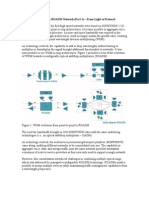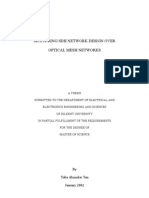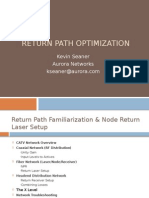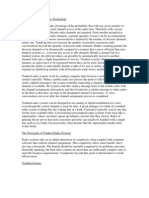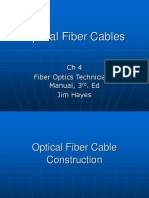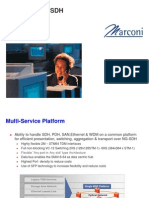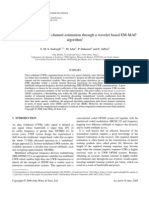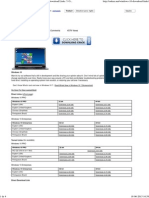DWDM in Metropolitan Area Networks
DWDM in Metropolitan Area Networks
Uploaded by
Chuthaporn MarkyouCopyright:
Available Formats
DWDM in Metropolitan Area Networks
DWDM in Metropolitan Area Networks
Uploaded by
Chuthaporn MarkyouOriginal Title
Copyright
Available Formats
Share this document
Did you find this document useful?
Is this content inappropriate?
Copyright:
Available Formats
DWDM in Metropolitan Area Networks
DWDM in Metropolitan Area Networks
Uploaded by
Chuthaporn MarkyouCopyright:
Available Formats
C H A P T E R
DWDM in Metropolitan Area Networks
The long distances made possible by advances in technologies such as optical amplifiers, dispersion compensators, and new fiber types, resulted in the initial deployment of DWDM technology in the long-haul transoceanic and terrestrial networks. Once these technologies became commercially viable in the long-haul market, it was the next logical step to deploy them in the metropolitan area and, eventually, in the access networks using hybrid architectures of fiber and coaxial media. We begin the following discussion by considering the main transport and network technologies used in metropolitan networks. We then briefly explore some of the potential applications for DWDM in these networks and examine the topologies that can be deployed. We continue by examining the protection mechanisms and schemes that are available to ensure reliability, and we conclude with a look at the future of optical networking.
Technologies in the Metropolitan Market
Numerous technologies for transport and encapsulation of data have been advocated in the metropolitan market. A characteristic of these networks, as noted earlier, is that they are called upon to support a variety of older and new traffic types and rates. Overall, however, there is a trend toward using a common optical layer for transporting digital data.
SONET/SDH
SONET/SDH has been the foundation for MANs over the last decade, serving as the fundamental transport layer for both TDM-based circuit switched network and most overlay data networks. While SONET/SDH has evolved into a very resilient technology, it remains fairly expensive to implement. Inherent inefficiencies in adapting data services to the voice-optimized hierarchy and an inflexible multiplexing hierarchy remain problematic. More importantly, capacity scaling limitationsOC-768 may be the practical limit of SONET/SDHand unresponsiveness to bursty IP traffic make any TDM-based technology a poor choice for the future.
ATM
Many service providers favor ATM because it can encapsulate different protocols and traffic types into a common format for transmission over a SONET infrastructure. Meanwhile the data networking world, which is overwhelmingly IP-oriented, favors packet over SONET (POS), which obviates the costly ATM
Introduction to DWDM Technology OL-0884-01
3-1
Chapter 3 Technologies in the Metropolitan Market
DWDM in Metropolitan Area Networks
intermediate layer. Advancements in IP, combined with the scaling capacity of gigabit and multigigabit routers, make it possible to envisage an IP-based network that is well suited for carrying primarily data traffic, and secondarily voice. Nevertheless ATM remains strong in the metropolitan area. It can accommodate higher speed line interfaces and provide managed virtual circuit services while offering traffic management capabilities. Thus ATM edge devices are commonly used to terminate traffic, including VoIP, DSL, and Frame Relay.
Gigabit Ethernet
Gigabit Ethernet (GE) is a proven technology for easy migration from and integration into traditional Ethernet. It is relatively inexpensive compared to other technologies that offer the same transmission rate, but does not provide quality of service (QoS) or fault tolerance on its own. When confined to point-to-point topologies, collisions and carrier sense multiple access (CSMA) are not of concern, resulting in more effective use of the full bandwidth. Because the optical physical layer can support much longer distances than traditional Category 5 cable, Gigabit Ethernet over fiber (1000BASE-LX, for example) can be extended into the wide-area realm using DWDM. The latest advancement in Ethernet technology, 10 Gigabit Ethernet, is being driven by a need to interconnect Ethernet LANs operating at 10, 100, or 1000 Mbps. Ten Gigabit Ethernet can be used for aggregating slower access links, in the backbone networks, and for WAN access. Using 1550-nm serial lasers, distances of 40 to 80 km (25 to 50 mi) are possible with 10 Gigabit Ethernet over standard SM fiber. With such technology, service providers can build simple Ethernet networks over dark fiber without SONET or ATM and provision high-speed 10/100/1000 Mbps services at very low cost. In addition, a very short reach (VSR) OC-192 interface can be used to connect 10 Gigabit Ethernet to DWDM equipment over MM fiber. Ethernet offers the technical advantages of a proven, adaptable, reliable, and uncomplicated technology. Implementations are standard and interoperable, and cost is much less than SONET or ATM. Architecturally, Ethernets advantage is its emerging potential to serve as a scalable, end-to-end solution. Network management can also be improved by using Ethernet across the MAN and WAN.
IP
Clearly, as traditional circuit-switched services migrate to IP networks and data grows, networks must evolve to accommodate the traffic. However, IP may need to become as complex as ATM to replace its functionality. Thus, both ATM and IP are candidates for transport directly over DWDM. In either case, the result is simplified network infrastructure, lower cost due to fewer network elements and less fiber, open interfaces, increased flexibility, and stability. The question is, in which format will IP travel over an optical network: IP over ATM over SONET, IP over SONET (as POS), or IP over Gigabit Ethernet or 10 Gigabit Ethernet? (See Figure 3-1.)
Introduction to DWDM Technology
3-2
OL-0884-01
Chapter 3
DWDM in Metropolitan Area Networks Technologies in the Metropolitan Market
Figure 3-1
Data Link and Network Protocols over the Optical Layer
GE/10GE
IP ATM SONET
FC
49368
Optical physical layer
Fibre Channel
Fibre Channel is the predominant data link technology used in storage area networks (SANs). See the Storage Area Networks section on page 3-5. Fibre Channel is an economical replacement for the Small Computer System Interface (SCSI) protocol as a high-speed interface for applications such as data backup, recovery, and mirroring. Fibre Channel interfaces are available at 100 MBps today; 200 MBps interfaces should be available in the near future, and 400 MBps interfaces are in testing.
Note
By convention, transfer rates for storage are specified in megabytes per second (MBps). Fibre Channel comes without the very short distance limitations of SCSI; it also avoids the termination restrictions of SCSI because each node acts as an optical repeater. Fibre Channel can be implemented in a point-to-point, arbitrated loop, or mesh topology using a switch. As shown in Figure 3-1, Fibre Channel, like other protocols, can be carried directly over the optical layer using DWDM.
Dynamic Packet Transport
Dynamic Packet Transport (DPT) is a Cisco protocol that provides an alternative to SONET for more efficient transport of data in ring architectures. DPT supports basic packet processing, fairness, multicasting, Intelligent Protection Switching (IPS), topology discovery, Address Resolution Protocol (ARP), routing, and network management. DPT can run over dark fiber, SONET, or WDM. DPTs chief advantage over SONET is its ability to reuse bandwidth that would have otherwise been lost. Bandwidth is consumed only on traversed segments, and multiple nodes can transmit concurrently. DPT is based on bidirectional counter rotating rings (see Figure 3-2). Packets are transported on both rings in concatenated payload, while control messages are carried in the opposite direction from data.
Introduction to DWDM Technology OL-0884-01
3-3
Chapter 3 Technologies in the Metropolitan Market
DWDM in Metropolitan Area Networks
Figure 3-2
DPT Ring Architecture
Outer ring
Outer ring data Outer ring control
Inner ring control
Inner ring data
Inner ring
49369
FDDI
FDDI is at this point a legacy technology. Having served a need at one time, it has been replaced by more advanced technologies. Although FDDI is capable of scaling to the metropolitan area, it is also a shared media technology with a relatively low capacity by current standards. This limitation, along with falling availability of FDDI interfaces on network equipment, is causing FDDI to be replaced by Gigabit Ethernet, or ATM. Nevertheless, it is also a protocol that can be transparently transported over the optical layer using DWDM.
Support for Legacy Traffic
In spite of the disproportionate growth of data traffic versus voice, legacy traffic wont suddenly vanish. Networks must support diverse low speed connections in addition to newer, higher speed data connection. Thus DWDM must be complimented by electrical (TDM/FDM) multiplexing to ensure efficient use of lightwaves. At the same time, legacy traffic must be augmented with high-capacity data transport without impacting efficient IP transport. For ISPs, the situation is different: All of their traffic is IP. ISPs need rapid build-out of networks and favor packet-over-lightwave or Gigabit Ethernet, rather than ATM or SONET. Other requirements of this market include load sharing strategies for resilience, leverage of dark fiber, and simpler datacom-like management.
Introduction to DWDM Technology
3-4
OL-0884-01
Chapter 3
DWDM in Metropolitan Area Networks Applications and Services in the MAN
Applications and Services in the MAN
The metropolitan network market is being driven by demand for new application services and the introduction of high speed access. Taken together, these forces are creating a bottleneck in the MAN. New applications include e-commerce transactions, packetized voice, and streaming multimedia. New services, primarily to the enterprise, include interconnecting and consolidating data centers, transparent extension of the LAN across the MAN by connecting geographically disparate locations using wavelengths over dark fiber, a trend towards SAN architecture, the server-less office, real-time transactions backup, and high-speed disaster recovery. For service providers, new services include support for access technologies such as DSL, cable, and wireless (which still requires a land-based transport infrastructure) and wavelength leasing or wavelength-on-demand. Two of the most important applications for DWDM technology in the MAN are in the areas of SANs and SONET migration.
Storage Area Networks
Storage area networks (SANs) represent the latest stage in the evolution of mass data storage for enterprises and other large institutions. In host-centric environments, storage, as well as applications, was centralized and centrally managed. With the advent of client/server environments, information that was previously centralized became distributed across the network. The management problems created by this decentralization are addressed in two principal ways: network attached storage (NAS), where storage devices are directly attached to the LAN, and SANs. Composed of servers, storage devices (tapes, disk arrays), and network devices (multiplexers, hubs, routers, switches, and so on), a SAN constitutes an entirely separate network from the LAN (see Figure 3-3). As a separate network, the SAN can relieve bottlenecks in the LAN by providing the resources for applications such as data mirroring, transaction processing, and backup and restoration.
Figure 3-3 SAN Architecture
Local area network Server Server Server Server
Fibre Channel switch
FC
FC
Fibre Channel switch Storage area network
Tape Disk array
Tape
49370
Disk array
Introduction to DWDM Technology OL-0884-01
3-5
Chapter 3 Applications and Services in the MAN
DWDM in Metropolitan Area Networks
A number of types of interfaces have been used to connect servers to devices in a SAN. The most prevalent is IBMs Enterprise System Connection (ESCON), a 17-MBps half-duplex protocol over fiber. Fibre Channel, on which IBMs FICON is based, is also frequently employed in SANs and has a much higher capacity than ESCON (see the Fibre Channel section on page 3-3.) Both technologies, however, have significant distance limitations. For example, the standard maximum distance without repeaters is around 3 km (1.9 mi) for half duplex ESCON and around 10 km (6.2 mi) for full duplex 100-MBps Fibre Channel. There is performance degradation as distances increase beyond these numbers. This distance limitation can be overcome by transporting data between one or more enterprise locations and one or more SANs over the optical layer using DWDM. In Figure 3-4, for example, the distance separating the enterprise location and the SAN sites can be greatly extended. Access to the ring is by way of satellite OADMs with Fibre Channel or ESCON interfaces at each SAN location (one of these could provide data mirroring). These interfaces can also support Sysplex Timer and Sysplex Coupling Link interfaces, used in IBM environments for distributing loads across the members of a server complex.
Figure 3-4 SAN Access over the Optical Layer
Enterprise
Fibre Channel ESCON
OADM
OADM
Fibre Channel ESCON
New York
New Jersey
In addition to overcoming distance limitations, DWDM can also reduce fiber requirements in SANs. Both ESCON and FICON require a pair of fibers for every channel. By multiplexing these channels over DWDM transport, significant savings can be realized.
Introduction to DWDM Technology
3-6
49371
Primary SAN
Standby SAN
OL-0884-01
Chapter 3
DWDM in Metropolitan Area Networks Applications and Services in the MAN
Migration from SONET/SDH
As a transport technology, SONET is an agnostic protocol that can transport all traffic types, while providing interoperability, protection schemes, network management, and support for a TDM hierarchy. Although SONET may continue to be the interface standard and transport protocol of choice well into the foreseeable future, upgrading it is expensive, as line-rate specific network elements are required at each point of traffic ingress or egress. Using DWDM to increase the capacity of embedded fiber, while preserving SONET infrastructure, offers an alternative to expensive SONET upgrades. Migration from SONET to DWDM may in fact be the single most important application in the near term. In general, this migration begins by replacing backbones with DWDM, then moves toward the edges of the network. In one common scenario, bandwidth on a SONET ring can be increased greatly by replacing SONET ADMs with DWDM equipment. In the example shown in Figure 3-5, there are three options for upgrading the ring:
Replace or upgrade the equipment; for example, from OC-48 to OC-192. Install a new ring on new or existing fiber. Install one or more new rings by deploying DWDM.
Migrating the SONET Ring to DWDMBefore
Figure 3-5
SONET
ADM
SONET
ADM
SONET
ADM
ADM
49372
SONET
The third option is shown in Figure 3-6. By using DWDM to increase the capacity of the existing ring, one fiber can essentially act as many.
Introduction to DWDM Technology OL-0884-01
3-7
Chapter 3 Applications and Services in the MAN
DWDM in Metropolitan Area Networks
Figure 3-6
Migrating the SONET Ring to DWDMFirst Stage
SONET
ADM
SONET
ADM
SONET
ADM
SONET
ADM
ADM
ADM
SONET
SONET
In a second type of scenario, DWDM can be used to remove an entire class of equipment, the SONET ADMs. This change, which might constitute a second phase of SONET migration, allows routers and other devices to bypass SONET equipment and interface directly to DWDM, while simplifying traffic from IP/ATM/SONET to POS to eventually IP directly over the optical layer (see Figure 3-7).
Introduction to DWDM Technology
3-8
49373
OL-0884-01
Chapter 3
DWDM in Metropolitan Area Networks Topologies and Protection Schemes for DWDM
Figure 3-7
Migrating the SONET Ring to DWDMSecond Stage
OC-48
OC-12 OC-48
OC-12 OC-48
In this phase of migration, end user sites are served by OADMs rather than SONET ADMs. In this way DWDM rings and mesh networks can eliminate the increased cost and complexity of introducing more SONET elements into the network to meet demand. The advantage here for carriers is the ability to offer bit-rate-independent services, freeing them from the DS1/DS3/OC-n framework. Such a scheme would also allow enterprise LAN access to be extended across the MAN or WAN without a SONET infrastructure. A further advantage in migrating from SONET to the optical layer is that protection and restoration becomes less susceptible to failure of electronic components; a common survivability platform for all network services is created, including those without built-in protection.
Topologies and Protection Schemes for DWDM
Network architectures are based on many factors, including types of applications and protocols, distances, usage and access patterns, and legacy network topologies. In the metropolitan market, for example, point-to-point topologies might be used for connecting enterprise locations, ring topologies for connecting inter-office facilities (IOFs) and for residential access, and mesh topologies might be used for inter-POP connections and connections to the long-haul backbone. In effect, the optical layer must be capable of supporting many topologies and, because of unpredictable developments in this area, those topologies must be flexible. Today, the main topologies in deployment are point-to-point and ring. With point-to-point links over DWDM between large enterprise sites, there needs only to be a customer premise device for converting application traffic to specific wavelengths and multiplexing. Carriers with linear-ring topologies can evolve toward full rings based on OADMs. As configurable optical cross-connects and switches become more common, these point-to-point and ring networks will be interconnected into meshes, transforming optical metropolitan networks into fully flexible platforms.
Introduction to DWDM Technology OL-0884-01
49374
3-9
Chapter 3 Topologies and Protection Schemes for DWDM
DWDM in Metropolitan Area Networks
Point-to-Point Topologies
Point-to-point topologies can be implemented with or without OADM. These networks are characterized by ultra-high channel speeds (10 to 40 Gbps), high signal integrity and reliability, and fast path restoration. In long-haul networks, the distance between transmitter and receiver can be several hundred kilometers, and the number of amplifiers required between endpoints is typically less than 10. In the MAN, amplifiers are often not needed. Protection in point-to-point topologies can be provided in a couple of ways. In first generation equipment, redundancy is at the system level. Parallel links connect redundant systems at either end. Switchover in case of failure is the responsibility of the client equipment (a switch or router, for example), while the DWDM systems themselves just provide capacity. In second generation equipment, redundancy is at the card level. Parallel links connect single systems at either end that contain redundant transponders, multiplexers, and CPUs. Here protection has migrated to the DWDM equipment, with switching decisions under local control. One type of implementation, for example, uses a 1 + 1 protection scheme based on SONET Automatic Protection Switching (APS). See Figure 3-8.
Figure 3-8 Point-to-Point Architecture
APS
APS
OADM
APS
APS
49375
Ring Topologies
Rings are the most common architecture found in metropolitan areas and span a few tens of kilometers. The fiber ring might contain as few as four wavelength channels, and typically fewer nodes than channels. Bit rate is in the range of 622 Mbps to 10 Gbps per channel. Ring configurations can be deployed with one or more DWDM systems, supporting any-to-any traffic, or they can have a hub station and one or more OADM nodes, or satellites (see Figure 3-9). At the hub node traffic originates, is terminated and managed, and connectivity with other networks is established. At the OADM nodes, selected wavelengths are dropped and added, while the others pass through transparently (express channels). In this way, ring architectures allow nodes on the ring to provide access to network elements such as routers, switches, or servers by adding or dropping wavelength channels in the optical domain. With increase in number of OADMs, however, the signal is subject to loss and amplification can be required.
Introduction to DWDM Technology
3-10
OL-0884-01
Chapter 3
DWDM in Metropolitan Area Networks Topologies and Protection Schemes for DWDM
Figure 3-9
DWDM Hub and Satellite Ring Architecture
Hub
1, 2,....n
1, 2,....n
OADM
OADM
9-12 1, 2,....n
1, 2,....n
OADM
1-4 1, 2,....n
5-8
Candidate networks for DWDM application in the metropolitan area are often already based on SONET ring structures with 1 + 1 fiber protection. Thus schemes such as Unidirectional Path Switched Ring (UPSR) or Bidirectional Line Switched Ring (BLSR) can be reused for DWDM implementations. Figure 3-10 shows a UPSR scheme with two fibers. Here, hub and nodes send on two counter-rotating rings, but the same fiber is normally being used by all equipment to receive the signal; hence the name unidirectional. If the working ring should fail, the receiving equipment switches to the other pair. Although this provides full redundancy to the path, no bandwidth reuse is possible, as the redundant fiber must always be ready to carry the working traffic. This scheme is most commonly used in access networks.
Figure 3-10 UPSR Protection on a DWDM Ring
Hub
UPSR
OADM
OADM
Other schemes, such as Bidirectional Line Switched Ring (BLSR), allow traffic to travel from the sending to the receiving node by the most direct route. Because of this, BLSR is considered preferable for core SONET networks, especially when implemented with four fibers, which offers complete redundancy.
49377
49376
Introduction to DWDM Technology OL-0884-01
3-11
Chapter 3 Topologies and Protection Schemes for DWDM
DWDM in Metropolitan Area Networks
Mesh Topologies
Mesh architectures are the future of optical networks. As networks evolve, rings and point-to-point architectures will still have a place, but mesh promises to be the most robust topology. This development will be enabled by the introduction of configurable optical cross-connects and switches that will in some cases replace and in other cases supplement fixed DWDM devices. From a design standpoint, there is a graceful evolutionary path available from point-to-point to mesh topologies. By beginning with point-to-point links, equipped with OADM nodes at the outset for flexibility, and subsequently interconnecting them, the network can evolve into a mesh without a complete redesign. Additionally, mesh and ring topologies can be joined by point-to-point links (see Figure 3-11).
Figure 3-11 Mesh, Point-to-Point, and Ring Architectures
Ring Mesh Point-to-point
DWDM mesh networks, consisting of interconnected all-optical nodes, will require the next generation of protection. Where previous protection schemes relied upon redundancy at the system, card, or fiber level, redundancy will now migrate to the wavelength level. This means, among other things, that a data channel might change wavelengths as it makes its way through the network, due either to routing or to a switch in wavelength because of a fault. The situation is analogous to that of a virtual circuit through an ATM cloud, which can experience changes in its virtual path identifier (VPI)/virtual channel identifier (VCI) values at switching points. In optical networks, this concept is sometimes called a light path. Mesh networks will therefore require a high degree of intelligence to perform the functions of protection and bandwidth management, including fiber and wavelength switching. The benefits in flexibility and efficiency, however, are potentially great. Fiber usage, which can be low in ring solutions because of the requirement for protection fibers on each ring, can be improved in a mesh design. Protection and restoration can be based on shared paths, thereby requiring fewer fiber pairs for the same amount of traffic and not wasting unused wavelengths. Finally, mesh networks will be highly dependent upon software for management. A protocol based on Multiprotocol Label Switching (MPLS) is under development to support routed paths through an all-optical network. In addition, network management will require an as-yet unstandardized channel to carry messages among the network elements.
Introduction to DWDM Technology
3-12
OL-0884-01
49378
Chapter 3
DWDM in Metropolitan Area Networks Practical Considerations in Deploying DWDM
Practical Considerations in Deploying DWDM
In deploying a DWDM-based network there are some considerations that will affect ones choice of vendor, equipment type, design, and so on. Some of these questions are as follows:
Is the DWDM system compatible with existing fiber plant? As discussed in the Optical Fibers section on page 2-5, some types of older fiber are not suitable for DWDM use, while newer types, such as NZ-DSF, are optimized for DWDM. Standard SM fiber (G. 652), which currently accounts for the majority of installed fiber, can support DWDM in the metropolitan area. If new fiber must be laid, a type should be chosen that will allow for future growth, particularly as DWDM systems expand into new wavelength regions and higher bit rates.
What is my migration and provisioning strategy? Because DWDM is capable of supporting massive growth in bandwidth demands over time without forklift upgrades, it represents a long-term investment. As discussed in the Mesh Topologies section on page 3-12, both point-to-point and ring topologies can serve as foundations for future growth into mesh topologies. Planning should allow for flexible additions of nodes, such as OADMs, to meet the changing demands of customers and usage.
What network management tools can I use? A comprehensive network management tool will be needed for provisioning, performance monitoring, fault identification and isolation, and remedial action. Such a tool should be standards-based (SNMP, for example) and be able to interoperate with the existing operating system.
What is my strategy for protection and restoration? Designing a protection strategy is a complex process that must take into account many variables. There are hard failures (equipment failures, such as laser or photodetector, and fiber breaks) and soft failures such as signal degradation (for example, unacceptable BER). The former must be addressed through redundancy at the device, component, or fiber level. The latter must be addressed by the system through intelligent wavelength monitoring and management. Protection and survivability strategies depend upon service type, system, and network architectures. In many networks, they also depend on the transport protocol.
Two additional and important considerations are calculation of the optical power budget and interoperability.
Optical Power Budget
Optical power budgets, or link loss budgets, are a critical part of planning an optical network. Vendors must provide guidelines, or engineering rules, to use for their equipment. In general, there are many factors that can result in optical signal loss. The most obvious of these is the distance of the fiber itself; this tends to be the most important factor in long-haul transport. In MANs, the number of access nodes, such as OADMs, is generally the most significant contributor to optical loss. The key to precise optical power budget calculation is to get an accurate reading on the fiber using an optical time domain reflectometer (OTDR). Using an OTDR, you can obtain the following information about a span:
Length of the fiber Attenuation in dB of the whole link, as well as the attenuation of separate sections of the fiber (if any)
Introduction to DWDM Technology OL-0884-01
3-13
Chapter 3 Future of DWDM
DWDM in Metropolitan Area Networks
Attenuation characteristics of the fiber itself Locations of connectors, joints, and faults in the cable
The goal in calculating optical loss is to ensure that the total loss does not exceed the span budget. The following are typical values for the main elements in a span:
Connector splice lossThis is 0.2 dB if the connectors are modern single-mode connectors from the same vendor. If the manufacturers of the two connectors (halves of the connection) are different, then the average loss is 0.35 dB. Fiber lossThis is about 0.25 dB/km due to attenuation. Fiber agingThis is about 2 dB over the life of the system.
Because optical power loss (or gain) is measured in a logarithmic value, decibels (dBs), the combined effect of all contributing elements can be calculated using simple addition. Assume a span budget of 25 dBm (a dBm is the signal power level in relation to one milliwatt), we can make the following addition: total system loss + (fiber length *.25) + fiber aging margin + connector/splice losses If the sum is less than 25, then we are within the span budget. If not, then some changes must be made. This might include adding an amplifier or reducing the number of loss-inducing elements on the span. Fiber conditioning, which includes resplicing fiber, connector cleaning, and so on, may also be required to reduce loss. It is also important to ensure that the client side or tributary equipment does not overdrive the local receive laser of the DWDM equipment. This means that the client or tributary equipment must operate within the specifications of the DWDM client interface. Although it is generally not an issue at the distances used in the MAN, remember that optical amplifiers boost the entire input, including noise. Thus over time the signal-to-noise ratio becomes so high that a clear signal can no longer be detected at the receiving end. At this point regenerators must be used to perform the 3R functions.
Interoperability Issues
Because DWDM uses specific wavelengths for transmission, the wavelengths used must be the same on either end of any given connection. Toward this end, the ITU has standardized on a grid with spacings of 100 GHz (see Table 2-1 on page 2-14). However, vendors may use wider spacing, sometimes at 200 GHz, or narrower. In addition, different vendors who do use the same grid may not use the same lambda numbering scheme. That is, lambda 1 on vendor As equipment may be assigned a different wavelength from lambda 1 on vendor Bs equipment. Hence, it is important to be aware of the potential interoperability problems posed by different grid alignments. Other interoperability issues include power levels, inter- and intra-channel isolation, PMD tolerances, and fiber types. All these contribute to the challenges of transmission between different systems at Layer 1.
Future of DWDM
DWDM will continue to provide the bandwidth for large amounts of data. In fact, the capacity of systems will grow as technologies advance that allow closer spacing, and therefore higher numbers, of wavelengths. But DWDM is also moving beyond transport to become the basis of all-optical networking
Introduction to DWDM Technology
3-14
OL-0884-01
Chapter 3
DWDM in Metropolitan Area Networks Future of DWDM
with wavelength provisioning and mesh-based protection. Switching at the photonic layer will enable this evolution, as will the routing protocols that allow light paths to traverse the network in much the same way as virtual circuits do today. These and other advances are converging such that an all-optical infrastructure can be envisioned. Figure 3-12 shows an example of such an infrastructure, using mesh, ring, and point-to-point topologies at the optical layer to support the needs of enterprise, metropolitan access, and metropolitan core networks.
Figure 3-12 Next Generation Metropolitan Optical Network
POP Enterprise Residential access Data center To/from national backbone
DWDM rings
DWDM mesh
DWDM bus
49379
Introduction to DWDM Technology OL-0884-01
3-15
Chapter 3 Future of DWDM
DWDM in Metropolitan Area Networks
Introduction to DWDM Technology
3-16
OL-0884-01
You might also like
- Optical Switching TechnologyDocument7 pagesOptical Switching TechnologyKumar Goud.KNo ratings yet
- Empire-East-Highland-City-Sales-Kit - (March-2020) 2Document48 pagesEmpire-East-Highland-City-Sales-Kit - (March-2020) 2Richard Brian RemigioNo ratings yet
- Carrier Ethernet EssentialsDocument14 pagesCarrier Ethernet EssentialsHien NguyenNo ratings yet
- Seminar Report 03Document26 pagesSeminar Report 03Allu AlthafNo ratings yet
- Anatomy of A ROADM NetworkDocument7 pagesAnatomy of A ROADM Networkchaidar_lakareNo ratings yet
- Making Telecoms Work: From Technical Innovation to Commercial SuccessFrom EverandMaking Telecoms Work: From Technical Innovation to Commercial SuccessNo ratings yet
- LTE Self-Organising Networks (SON): Network Management Automation for Operational EfficiencyFrom EverandLTE Self-Organising Networks (SON): Network Management Automation for Operational EfficiencySeppo HämäläinenNo ratings yet
- SDH Principle-20080528-ADocument48 pagesSDH Principle-20080528-AHibetullah KılıçNo ratings yet
- Chapter1 - Part 1 SWDocument36 pagesChapter1 - Part 1 SWAsy RafNo ratings yet
- DWDMDocument116 pagesDWDMShareena Iftikhar ChaudhryNo ratings yet
- Product Data Sheet0900aecd806c4b14 PDFDocument5 pagesProduct Data Sheet0900aecd806c4b14 PDFVíctor MayaNo ratings yet
- Dispersion PDFDocument48 pagesDispersion PDFrafaqat123No ratings yet
- Laboratory Manual For Copper CablingDocument48 pagesLaboratory Manual For Copper CablingBikash BhattaraiNo ratings yet
- CD and PMD TestingDocument4 pagesCD and PMD Testingsatian_aNo ratings yet
- Transmission - I - 06 - 200909 Work Principle of DWDM 62PDocument62 pagesTransmission - I - 06 - 200909 Work Principle of DWDM 62PDon D Dada100% (1)
- Passive Optical Network (PON) TopologiesDocument31 pagesPassive Optical Network (PON) TopologiesSudhashree MutuswamyNo ratings yet
- DSCB (DownStream Channel Bonding) Tech DeepDiveDocument25 pagesDSCB (DownStream Channel Bonding) Tech DeepDive문태영No ratings yet
- NEW Advanced Communication Laboratory ManualDocument54 pagesNEW Advanced Communication Laboratory Manualkeerthans_150% (4)
- Literature ReviewDocument6 pagesLiterature ReviewtazebNo ratings yet
- Selection of Different ITU-T G.652-FinalDocument8 pagesSelection of Different ITU-T G.652-FinalanjanivaishNo ratings yet
- WIMAXDocument206 pagesWIMAXammezzNo ratings yet
- Gpon Vs EponDocument17 pagesGpon Vs Eponkflim100% (1)
- Introduction To Optical AmplifiersDocument6 pagesIntroduction To Optical AmplifiersMohanish PareekNo ratings yet
- Measuring Optical Link Loss GA-TN-048-00Document6 pagesMeasuring Optical Link Loss GA-TN-048-00funnyguyguyNo ratings yet
- Televes OLT512 Optical Line TerminalDocument1 pageTeleves OLT512 Optical Line TerminalBastian AtenasNo ratings yet
- Optical Modulation - Formats1Document23 pagesOptical Modulation - Formats1Mushfiqur Rahman Masuk100% (1)
- Cisco Docsis 3.0 DesignDocument105 pagesCisco Docsis 3.0 Designgerman682001No ratings yet
- GPON: The Standard For PON Deployment and Service Evolution: OSI Confidential InformationDocument23 pagesGPON: The Standard For PON Deployment and Service Evolution: OSI Confidential Informationchaidar_lakareNo ratings yet
- WDM-DWDM Systems & ComponentsDocument47 pagesWDM-DWDM Systems & Componentsaarthi ravindranNo ratings yet
- Photonic Switching - Lecture 1Document60 pagesPhotonic Switching - Lecture 1Shivam GuptaNo ratings yet
- 07 WDMDocument66 pages07 WDMMauricio DominguezNo ratings yet
- r000 HST Broadcom XDSL UserGuideDocument108 pagesr000 HST Broadcom XDSL UserGuideChristian BurgosNo ratings yet
- SDH RingDocument101 pagesSDH Ringsoumen_das6883No ratings yet
- Return Path OptimizationDocument55 pagesReturn Path OptimizationYordano MorelNo ratings yet
- OLTS and OTDRDocument5 pagesOLTS and OTDRCandyNo ratings yet
- OTC000003 WDM Principle ISSUE1.1Document45 pagesOTC000003 WDM Principle ISSUE1.1khalis@hotmail.comNo ratings yet
- MTS-8000 Tester: All Your Optical Network Testing Needs Covered in A Single PlatformDocument16 pagesMTS-8000 Tester: All Your Optical Network Testing Needs Covered in A Single PlatformraduldelNo ratings yet
- TM-Series Brochure 2014Document6 pagesTM-Series Brochure 2014dsfdsf ewrNo ratings yet
- Calculating Fiber Optic Loss BudgetsDocument9 pagesCalculating Fiber Optic Loss BudgetsteomondoNo ratings yet
- OPTera Metro Dense Wave Division Multiplexing Optical NetworkingDocument10 pagesOPTera Metro Dense Wave Division Multiplexing Optical NetworkingBrent BrownellNo ratings yet
- 1830 PSS-4 R5-1 EN DataSheetDocument6 pages1830 PSS-4 R5-1 EN DataSheetramthe1No ratings yet
- Benefit of Trunked Radio TechnologyDocument4 pagesBenefit of Trunked Radio TechnologyOrpheo NgadimanNo ratings yet
- Optec Catalogue PDFDocument98 pagesOptec Catalogue PDFVijay Lakshmipathy0% (1)
- Frame Relay Is A StandardizedDocument3 pagesFrame Relay Is A StandardizedlaurNo ratings yet
- Optical Fiber Cables: Ch4 Fiber Optics Technician's Manual, 3 - Ed Jim HayesDocument31 pagesOptical Fiber Cables: Ch4 Fiber Optics Technician's Manual, 3 - Ed Jim HayesSohaib Omer Salih100% (1)
- Ethernet Over SDHDocument30 pagesEthernet Over SDHbuitheanh2207100% (1)
- Fiber Optic CommunicationDocument4 pagesFiber Optic Communicationeaglett100% (1)
- 2 DWDM Glownet 91 SlideDocument91 pages2 DWDM Glownet 91 SlidePhearun PayNo ratings yet
- Spatialnet: End-To-End Physical Network Inventory ManagementDocument3 pagesSpatialnet: End-To-End Physical Network Inventory ManagementtalhaNo ratings yet
- Long Haul DWDM SFP: Dense Wavelength Division Multiplexing (DWDM) Small Form Factor PuggableDocument21 pagesLong Haul DWDM SFP: Dense Wavelength Division Multiplexing (DWDM) Small Form Factor PuggablewaghmaresanjeevNo ratings yet
- The Ultimate Guide To Higher Baud Rates 0240 WP RevA 0220 PDFDocument11 pagesThe Ultimate Guide To Higher Baud Rates 0240 WP RevA 0220 PDFrobert adamsNo ratings yet
- Chapter 5Document129 pagesChapter 5Muizz ZainolNo ratings yet
- Maxtester Maxtester Maxtester: Smarter Simplicity For Everyday Vdsl2/Adsl2+ Fi Eld TestingDocument2 pagesMaxtester Maxtester Maxtester: Smarter Simplicity For Everyday Vdsl2/Adsl2+ Fi Eld TestingdchardwareNo ratings yet
- Exfo in Band Osa MjerenjeDocument4 pagesExfo in Band Osa MjerenjeFatima MasloNo ratings yet
- VoIP and Unified Communications: Internet Telephony and the Future Voice NetworkFrom EverandVoIP and Unified Communications: Internet Telephony and the Future Voice NetworkNo ratings yet
- Progress in Electromagnetics Research C, Vol. 11, 81-90, 2009Document10 pagesProgress in Electromagnetics Research C, Vol. 11, 81-90, 2009Chuthaporn MarkyouNo ratings yet
- 2p4a 0608Document3 pages2p4a 0608Chuthaporn MarkyouNo ratings yet
- Ultra Wideband OFDM Channel Estimation Through A Wavelet Based EM-MAP AlgorithmDocument11 pagesUltra Wideband OFDM Channel Estimation Through A Wavelet Based EM-MAP AlgorithmChuthaporn MarkyouNo ratings yet
- EXIT Charts For Non-Binary LDPC Codes: Geoffrey J. Byers and Fambirai TakawiraDocument6 pagesEXIT Charts For Non-Binary LDPC Codes: Geoffrey J. Byers and Fambirai TakawiraChuthaporn MarkyouNo ratings yet
- On The Design of Algebraic Space-Time Codes For MIMO Block-Fading ChannelsDocument13 pagesOn The Design of Algebraic Space-Time Codes For MIMO Block-Fading ChannelsChuthaporn MarkyouNo ratings yet
- 3fl00276 WB Ed03 p11 7302 7330 IsamDocument136 pages3fl00276 WB Ed03 p11 7302 7330 IsamLuis Felipe Gonzalez100% (1)
- Testing of CC Concrete blocks-Rev-R1Document2 pagesTesting of CC Concrete blocks-Rev-R1Guna SekaranNo ratings yet
- Handouts Prelims Art AppreciationDocument14 pagesHandouts Prelims Art AppreciationCalvin Wong, Jr.100% (13)
- Mkuser Does Not Work N AIX - FIXDocument9 pagesMkuser Does Not Work N AIX - FIXChristian FisherNo ratings yet
- DSM 6.2.1 DS918 V1.0 2018-Feb-03Document2 pagesDSM 6.2.1 DS918 V1.0 2018-Feb-03Lando PsrNo ratings yet
- Module Title Module 1: Database Environment Learning ObjectivesDocument6 pagesModule Title Module 1: Database Environment Learning ObjectivesVideo MusicNo ratings yet
- R12.2 Oracle Procurement Contracts Impl GuideDocument250 pagesR12.2 Oracle Procurement Contracts Impl GuideSree0% (2)
- Shoring and UnderpinningDocument35 pagesShoring and UnderpinningAnySikaNo ratings yet
- Introduction To Web Services Using Microsoft Visualstudio: DR Kevin McmanusDocument66 pagesIntroduction To Web Services Using Microsoft Visualstudio: DR Kevin McmanusVenkat RamanNo ratings yet
- E20 Heat Load Calculation SheetDocument1 pageE20 Heat Load Calculation SheetȘtefan C. Petre67% (3)
- Novavox x100p Se Installation GuideDocument51 pagesNovavox x100p Se Installation GuidegregoryalussierNo ratings yet
- SPMDocument17 pagesSPMmanojk.mauryaNo ratings yet
- Bill of Quantity F G H (B2 Column 22F Slab) Include Form Work, Exclude Concrete and Rebar (Conventional Form Work)Document2 pagesBill of Quantity F G H (B2 Column 22F Slab) Include Form Work, Exclude Concrete and Rebar (Conventional Form Work)Phanint NgounNo ratings yet
- Methodology For Stone Pitching Revetment On SlopesDocument3 pagesMethodology For Stone Pitching Revetment On SlopesRSBIPL NH17 LABNo ratings yet
- C V Sem 08 Chicago School of ArchitectureDocument42 pagesC V Sem 08 Chicago School of ArchitecturePrashna ShresthaNo ratings yet
- TROX Air Flow Control Design ManualDocument36 pagesTROX Air Flow Control Design Manualiask5275No ratings yet
- Managing The PowerPoint EnvironmentDocument14 pagesManaging The PowerPoint EnvironmentNuttuaNo ratings yet
- 6 (1) .Interfaces and CollectionsDocument86 pages6 (1) .Interfaces and CollectionsNaveen KumarNo ratings yet
- Ch. 1 Gathering & Analyzing InfoDocument16 pagesCh. 1 Gathering & Analyzing InfoUmer MaqboolNo ratings yet
- Monokote MK-6, MK-6/HY and MK-6s Product Data and Application InstructionsDocument2 pagesMonokote MK-6, MK-6/HY and MK-6s Product Data and Application InstructionsJijithpillaiNo ratings yet
- 64-Bit Performance: Ibm Websphere Application Server and 64-Bit PlatformsDocument18 pages64-Bit Performance: Ibm Websphere Application Server and 64-Bit Platformsapi-3835201No ratings yet
- AWS Solutions AssociateDocument7 pagesAWS Solutions AssociateAnonymous aeT7bvQNo ratings yet
- Windows 10 Technical Preview ISO Direct Download Links ! - On HAX - HTM PDFDocument4 pagesWindows 10 Technical Preview ISO Direct Download Links ! - On HAX - HTM PDFHermeneGildoAntónioMmiraNo ratings yet
- Anchor Bolts Design of Headed Anchor BoltsDocument12 pagesAnchor Bolts Design of Headed Anchor BoltsDoug LambNo ratings yet
- Skyhouse E-BrosurDocument36 pagesSkyhouse E-BrosurDjar NdoethNo ratings yet
- Kiwengwa 2Document10 pagesKiwengwa 2Hamad AllyNo ratings yet
- Company Profile - Hansfurniture Studio Private LimitedDocument8 pagesCompany Profile - Hansfurniture Studio Private LimitedHansFurniture Studio Private LimitedNo ratings yet
- Steel Arch Truss DetailsDocument1 pageSteel Arch Truss DetailsDolzMaGiCzNo ratings yet





